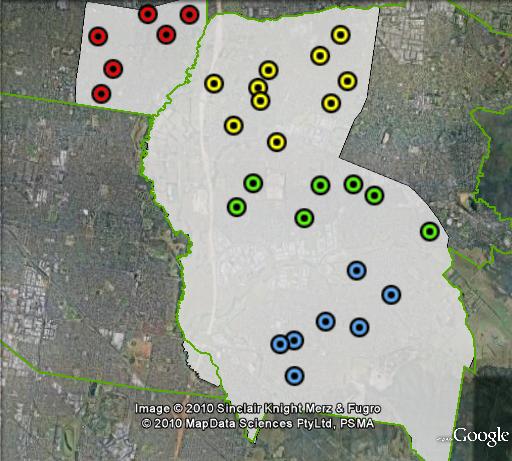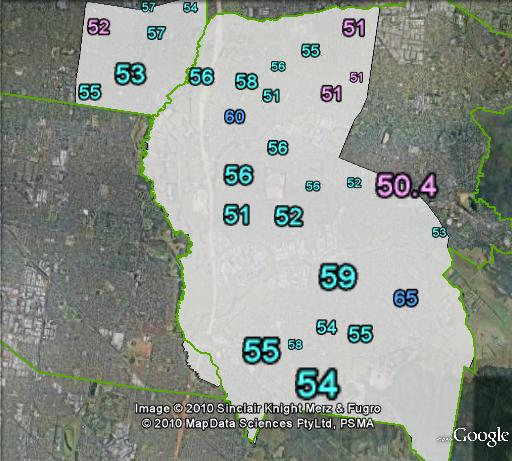LIB 5.1%
Incumbent MP
Chris Pearce, since 2001.
Geography
Eastern suburbs of Melbourne. Aston mostly lies within Knox council area, as well as a part of Whitehorse council area. Main suburbs include Wantirna, Bayswater, Scoresby and Rowville.
History
Aston was first created as part of the expansion of the House of Representatives in 1984, and has always been a marginal seat, although the seat has been consistently held by the Liberal Party for the last two decade and the Liberals pushed the seat out of ‘marginal seat’ territory at the 2004 election.
Aston was first won in 1984 by ALP candidate John Saunderson, who had previously been elected to Deakin at the 1983 election. Saunderson held on with a smaller margin in 1987 before losing with a 7% swing at the 1990 election.
The seat was won in 1990 by Peter Nugent (LIB). Nugent was known as a moderate Liberal who supported human rights issues. He was reelected with a slim margin in 1993 and pushed his margin out to almost 6% in 1996, and was re-elected again in 1998. Nugent died in April 2001 of a heart attack, triggering the Aston by-election.
The Howard government was not performing strongly in the first half of 2001, having seen disastrous results in state elections in Queensland and Western Australia and the loss of the blue-ribbon Brisbane seat of Ryan in another federal by-election.
The Liberal Party’s candidate, Chris Pearce, managed to hold on with 50.6% of the vote, limiting the anti-Liberal swing to 3.7%, which was seen as a strong result for the government, and the beginning of the turnaround which saw the Howard government returned at the 2001 election.
Pearce was reelected with just over 56% in 2001, and pushed his margin to over 63% in 2004, the largest victory margin in Aston’s history. Pearce was again re-elected in 2007, although his margin was cut to 5%.
Candidate
- Rachel Hanna (Family First)
- Rupert Evans (Labor)
- Alan Tudge (Liberal)
- Salore Craig (Greens)
Political situation
This seat is marginal but the Liberal Party has a decent margin to hold onto. Recent history suggests the Liberal Party is weakest without a prominent incumbent MP, suggesting that Chris Pearce’s retirement could give the ALP a chance to win this seat.
2007 result
| Candidate | Party | Votes | % | Swing |
| Chris Pearce | LIB | 43,519 | 50.71 | -7.84 |
| Gerry Raleigh | ALP | 33,332 | 38.84 | +7.67 |
| Adam Pepper | GRN | 4,492 | 5.23 | +0.37 |
| Peter Lake | FF | 2,978 | 3.47 | +0.66 |
| Rachal Aza | DEM | 1,246 | 1.45 | +0.22 |
| Doug Mitchell | CEC | 245 | 0.29 | -0.39 |
2007 two-candidate-preferred result
| Candidate | Party | Votes | % | Swing |
| Chris Pearce | LIB | 47,243 | 55.05 | -8.10 |
| Gerry Raleigh | ALP | 38,569 | 44.95 | +8.10 |
Booth breakdown
The Liberal Party won majorities in all areas, winning their biggest victories in Rowville. The ALP only won a small number of booths, most in the northeastern corner of the seat around Bayswater.

| Voter group | GRN % | LIB 2CP % | Total votes | % of votes |
| Rowville | 4.36 | 56.77 | 20,264 | 23.61 |
| Scoresby-Knoxfield | 4.92 | 52.63 | 16,385 | 19.09 |
| Wantirna-Bayswater | 4.93 | 53.94 | 20,048 | 23.36 |
| Vermont | 6.00 | 53.52 | 11,742 | 13.68 |
| Other votes | 6.38 | 57.66 | 17,373 | 20.25 |



Hi Ben, nice profile on Aston. There’s a small typo in one of the 2007 candidate’s names – it’s actually Rachal Aza, rather than Rachel.
It will be interesting to see if Aston shifts or not – I’m wondering if the Liberals doing so well there is also partly the result of demographic changes rather than just strong local members. They also did very well in the 2006 state election in that region – (they picked up Ferntree Gully and Bayswater and got over 60% TPP in Scoresby).
Thanks Polly, I’ll fix that ASAP. By the way, Nick C also made the maps and booth breakdowns for this seat.
I think this is another case of an outer suburban area changing from an outer suburban fringe battlers belt to an affluent middle range suburb.Polly’s right on Ferntree Gully and this seat (under its old name of Knox) was in 1973 one of only 3 Labor electorates east of the Yarra along with Carrum and Dandenong. Something has changed a lot here.
Geoff
It certainly has become quite affluent. Areas like Rowville and Lysterfield were the end of the earth 20 years ago; two street suburbs that were almost country towns. Now they’re covered with huge McMansion palaces. Also Wantirna South is home to the CityLife Church, so I’m sure alot of middle class religious types have moved in over the past few years.
Thanks for doing my electorate. I can’t tell you how happy I am to find out that I’m in the most Liberal area (not, tee hee).
Yeah, there are some large evangelical churches in the outer eastern suburbs. I also think the demographic who used to live in areas like Wantirna South and Rowville 20 years ago are now more likely to be in suburbs like Endeavour Hills and Narre Warren (which are in Holt, which is a strong seat for the ALP).
I wonder if the Greens can continue to grow their vote in Aston. The combined Green/Dems vote in 2001 was over 10%, so even though there are demographic changes in the area, surely there’s some room for them to improve? Maybe a strong campaign on PT issues in the area like the Rowville train line will help them.
BTW, Nick C, the maps are great.
Thanks Polly, but I’m only following Ben’s instructions, so it’s still all thanks to him.
That’s interesting about the comparison with the combined Greens and Dems vote from 2001, perhaps expected in a Liberal voting area since the Dems did better at attracting Liberal voters, but perhaps not so much in that sort of Liberal voting area. I’ve compiled some figures doing that comparison in NSW, which produced some quite surprising results – I expected the north shore to show the biggest difference, but a heap of booths in the Illawarra, the inner city and the lower Hunter, as well as large regional centres like Albury, Wagga and Lismore came out on top.
I think you all might be getting a little ahead of yourselves, with comments like ‘McMansions’ and ‘evangelical’.
The only major changes to the area over the last ten years have been the departure of many ‘older’ families (i.e.: parents with older kids, who have now moved out of home), and the increase in ‘younger’ families.
The wealth of the area has not increased drastically, and the campaigns from the candidates have always been the same (more public transport, better education, and better crime prevention).
That all being said, there’s a reason the Coalition won the 2004 Election in this seat by a massive 63-37 … Chris Pearce. He was a fantastic local candidate, people never heard the Labor candidate (Paul Morgan), and now that Chris is retiring, his replacement, Alan Tudge, has been just as effective at getting his face out there to the public (I doubt anyone would have heard of Labor’s current candidate, Rupert Evans).
Whilst the seat lost a lot of ground in 2007, it was (as with many seats) almost completely attributable to ‘Kevin 07’. I would envisage the Coalition increasing its 55-45 majority this year.
@David J – my observation of there being some large evangelical churches in the outer eastern suburbs is a statement of fact, and nothing else. How is that getting ahead of oneself?
There is no doubt that Chris Pearce, like Peter Nugent before him was a popular local federal member, however the Liberals have also polled well in the most recent state election, winning Ferntree Gully and Bayswater from the ALP, and having a massive TPP vote in Scoresby, so I don’t think the Liberal Party’s historically good performance in this region can be solely attributed to Chris Pearce. I also agree – I think the Coalition will increase its majority in Aston.
My prediction: Liberal retain, but with a 3-4% swing to Labor. Labor may come close, but probably not close enough.
This is a real chance for Labor with a 3% swing.
Great result for the ALP here, and I’m glad to be wrong about the Libs increasing their margin.